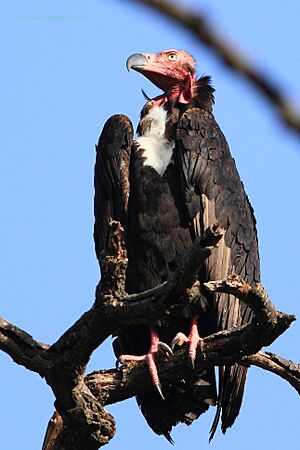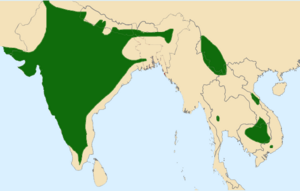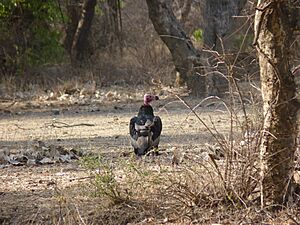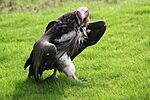Red-headed vulture facts for kids
Quick facts for kids Red-headed vulture |
|
|---|---|
 |
|
| Male in Bandhavgarh National Park, India | |
| Conservation status | |
| Scientific classification | |
| Genus: |
Sarcogyps
|
| Species: |
calvus
|
 |
|
| Current distribution range of red headed vulture | |
| Synonyms | |
|
|
The red-headed vulture (Sarcogyps calvus) is a large bird of prey. It is also called the Asian king vulture. You can find it mainly in India and nearby countries. Some smaller groups live in parts of Southeast Asia.
Contents
About the Red-headed Vulture
This vulture is a medium-sized bird. It is about 76 to 86 centimeters (30 to 34 inches) long. It weighs between 3.5 and 6.3 kilograms (7.7 to 13.9 pounds). Its wings can spread out to about 1.99 to 2.6 meters (6.5 to 8.5 feet) wide.
The red-headed vulture has a bright, bare head. In adult birds, the head is deep red or orange. Young birds have a paler red head. Its body is black. It has a light gray band near the base of its flight feathers. Male and female vultures have different eye colors. Males have lighter, whitish eyes. Females have dark brown eyes.
This vulture looks a lot like the Lappet-faced vulture. That bird lives in Africa and Arabia. People once thought they were in the same group of birds.
Where They Live
This vulture used to be very common. It lived across the Indian subcontinent. Its home stretched from India all the way to Singapore. Today, you can mostly find the red-headed vulture in northern India.
They usually live in open areas. This includes farmland and dry, sandy places. You can also find them in forests and river valleys. They live up to 3,000 meters (9,800 feet) above sea level.
Why They Are in Danger
The number of red-headed vultures has dropped very quickly. In 2004, they were listed as "near threatened." This means they were close to being in danger. But then, a medicine called diclofenac became widely used. This medicine was given to farm animals in India.
The Problem with Diclofenac
Diclofenac is very harmful to vultures. When vultures eat animals that were treated with diclofenac, they get sick. The medicine causes their kidneys to fail. Because of this, the red-headed vulture population has fallen by half almost every two years since the late 1990s. This bird, which once numbered hundreds of thousands, is now very close to extinction. In 2007, it was listed as "critically endangered." This is the highest risk level.
Scientists have found other medicines that are also bad for vultures. These include carprofen, flunixin, ibuprofen, and phenylbutazone. However, a medicine called meloxicam has been found to be safe for vultures. People are now encouraged to use meloxicam for farm animals instead.
Other Dangers
Hunting has also made it harder to find red-headed vultures. In places like Cambodia, special programs help protect these endangered birds. Hunters have started using poisons to catch fish or waterbirds. Sometimes, vultures eat these poisoned animals and die.
Other dangers include trees being cut down where they nest. They can also get hurt by power lines. Sometimes, they crash into them or get shocked.
Food Competition
In places where many vultures live, stronger types of vultures often get to the food first. These are usually Gyps vultures. They are better at finding and eating dead animals. This means the red-headed vulture might not get enough food. This can make it harder for them to survive.
In 2021, experts estimated there are only about 2,500 to 9,999 adult red-headed vultures left in the wild.





